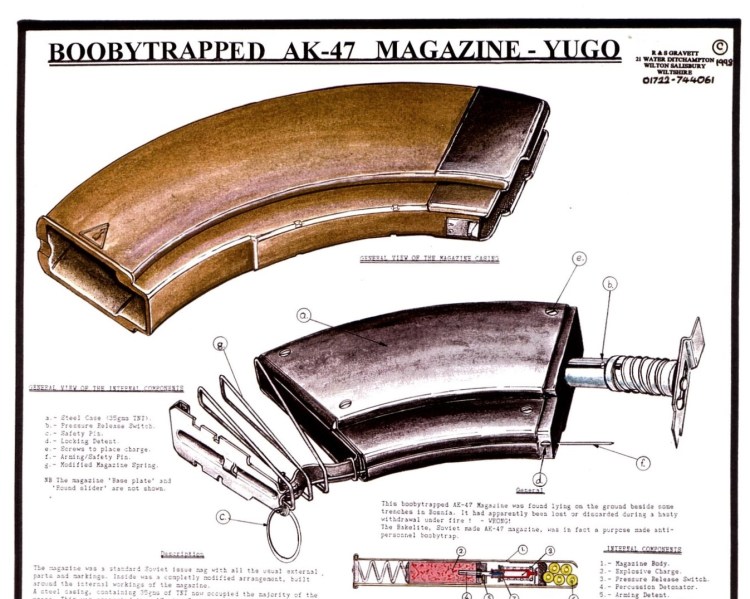Booby-Trapped Russian AK-47 Magazines are Showing Up in Ukraine
The use of booby-trapped military equipment is hardly a new idea, with a documented history of usage throughout wars in the 20th and 21st centuries. Considering the hot topic of late, the Russo-Ukrainian war, the Russians have been particularly busy in that area. While the matter of booby traps, in general, will have to wait for a future deep dive, one particular item offers a window into Russian thinking on the aforementioned topic, that being the explosive sabotage of Kalashnikov magazines.
In a posting made on March 25, 2022, Twitter user @ZloyAtoshnik posted a photo of a Kalashnikov rifle magazine cutaway depicting what appears to be a spring-loaded detonator mechanism, a buff-colored putty-like material resembling a plasticized explosive, and a message roughly translated (according to Google) to read “Guys do not pick up from old corpses or on the road.” This photo has since been shared in numerous social media posts.
Intrigued, I did some research and discovered a 1998 graphic describing a similar technique used in the 1990s during the Balkans campaign, specifically during the time frame of Operation Joint Endeavor, which was the U.S. arm of NATO’s larger Implementation Force. It was this organization that was charged with establishing specific aspects of the Dayton Peace Accords. The graphic, prepared by a now-retired United Kingdom EOD officer named Bob Gravett who was working for a company called BACTEC International Ltd. clearing mines and explosive remnants of war after the Bosnian conflict, depicts a professionally produced (not improvised) “bakelite” AK-47 Kalashnikov magazine with a complex spring operated and ball bearing controlled pressure release mechanism designed so that when the user removed rounds of ammunition from the magazine, pressure was relieved on the mechanism until finally a striker (also under spring pressure) shot downwards into a detonator, which in turn initiated the explosion of some 35 grams of TNT according to Mr. Gravett. The back story on the magazine reveals a potential Russian connection to the device. During my May 5, 2022 interview with Mr. Gravett, he advised the magazine was recovered in either late 1995 or early 1996 by a Bosnian patrol in Banja Luka, who heard what they believed to be a Serbian patrol, opening fire in that general direction. Mr. Gravett explained that after about 30 minutes, what he described as a Bosnian fighting patrol went out to investigate the incident, where they found Serb gear, blood-splattered webbing, and the aforementioned magazine. Fortunately, they examined the magazine and noted it had a pull ring still in place, which was obviously not normal, and they then realized the magazine was a booby trap style IED. As to a potential Russian nexus, the close relationship between Russia and Serbia, both largely Slavic nations, has been long documented,
Old Tricks for Old Dogs of War
Russian usage of booby-traps in Afghanistan has been long documented and includes innocuous items like toys and things like rifle magazines or other military equipment. The Russians, of course, are not the only military to booby trap rifle magazines. During the Vietnam War, for instance, U.S. programs included booby-trapped rifle magazines, the so-called “308 Special Devices,” as part of the overall 3801 Swimmer Weapon System. While the goals of these two programs were similar, 308 Special Devices such as rifle magazines, flashlights, binoculars, and even cameras (the technical literature for which can be found in now declassified U.S. military EOD manuals) were typically deployed by U.S. Navy SEALs and other special operations forces according to conversations I had with EOD SGM Mike Weber, USA (Retired). His comprehensive publication, Secret Weapons of the U.S. Navy SEALs during the Vietnam War, provides fascinating details of the 308 Special devices, with pictures showing the 308-17 device, which was a booby-trapped AK-47 magazine employing a microswitch. When a user removed ammunition (either manually or by firing the rifle) the microswitch would complete the circuit, causing the Composition C-4 filled magazine to explode.
Booby-Trapped Russian AK-47 Magazines are Showing Up in Ukraine
The use of booby-trapped military equipment is hardly a new idea, with a documented history of usage throughout wars in the 20th and 21st centuries. Considering the hot topic of late, the Russo-Ukrainian war, the Russians have been particularly busy in that area. While the matter of booby traps, in general, will have to wait for a future deep dive, one particular item offers a window into Russian thinking on the aforementioned topic, that being the explosive sabotage of Kalashnikov magazines.
In a posting made on March 25, 2022, Twitter user @ZloyAtoshnik posted a photo of a Kalashnikov rifle magazine cutaway depicting what appears to be a spring-loaded detonator mechanism, a buff-colored putty-like material resembling a plasticized explosive, and a message roughly translated (according to Google) to read “Guys do not pick up from old corpses or on the road.” This photo has since been shared in numerous social media posts.
Intrigued, I did some research and discovered a 1998 graphic describing a similar technique used in the 1990s during the Balkans campaign, specifically during the time frame of Operation Joint Endeavor, which was the U.S. arm of NATO’s larger Implementation Force. It was this organization that was charged with establishing specific aspects of the Dayton Peace Accords. The graphic, prepared by a now-retired United Kingdom EOD officer named Bob Gravett who was working for a company called BACTEC International Ltd. clearing mines and explosive remnants of war after the Bosnian conflict, depicts a professionally produced (not improvised) “bakelite” AK-47 Kalashnikov magazine with a complex spring operated and ball bearing controlled pressure release mechanism designed so that when the user removed rounds of ammunition from the magazine, pressure was relieved on the mechanism until finally a striker (also under spring pressure) shot downwards into a detonator, which in turn initiated the explosion of some 35 grams of TNT according to Mr. Gravett. The back story on the magazine reveals a potential Russian connection to the device. During my May 5, 2022 interview with Mr. Gravett, he advised the magazine was recovered in either late 1995 or early 1996 by a Bosnian patrol in Banja Luka, who heard what they believed to be a Serbian patrol, opening fire in that general direction. Mr. Gravett explained that after about 30 minutes, what he described as a Bosnian fighting patrol went out to investigate the incident, where they found Serb gear, blood-splattered webbing, and the aforementioned magazine. Fortunately, they examined the magazine and noted it had a pull ring still in place, which was obviously not normal, and they then realized the magazine was a booby trap style IED. As to a potential Russian nexus, the close relationship between Russia and Serbia, both largely Slavic nations, has been long documented,
Old Tricks for Old Dogs of War
Russian usage of booby-traps in Afghanistan has been long documented and includes innocuous items like toys and things like rifle magazines or other military equipment. The Russians, of course, are not the only military to booby trap rifle magazines. During the Vietnam War, for instance, U.S. programs included booby-trapped rifle magazines, the so-called “308 Special Devices,” as part of the overall 3801 Swimmer Weapon System. While the goals of these two programs were similar, 308 Special Devices such as rifle magazines, flashlights, binoculars, and even cameras (the technical literature for which can be found in now declassified U.S. military EOD manuals) were typically deployed by U.S. Navy SEALs and other special operations forces according to conversations I had with EOD SGM Mike Weber, USA (Retired). His comprehensive publication, Secret Weapons of the U.S. Navy SEALs during the Vietnam War, provides fascinating details of the 308 Special devices, with pictures showing the 308-17 device, which was a booby-trapped AK-47 magazine employing a microswitch. When a user removed ammunition (either manually or by firing the rifle) the microswitch would complete the circuit, causing the Composition C-4 filled magazine to explode.
A program somewhat related to 308 Special Devices, “Eldest Son,” dealt with both sabotaged(“Salted”) ammunition that would explode when fired, and booby-trapped devices. Although Eldest Son was employed during Vietnam by the U.S. Army Military Assistance Command Studies and Observations Group (MACV-SOG), with the intention being to cause fear in the minds of enemy combatants that the items they were using might explode in their face according to exchanges I had with EOD SGM Mike R. Vining, USA (Retired), and as described in his excellent publication, History of Army EOD in Vietnam.
Interestingly, Eldest Son did not end with the Vietnam war, nor is the technology unique. In a 2012 article in the New York Times, author C.J. Chivers details his research on the historical basis of such programs, along with recounting the use of the technique in Iraq, Syria, and Afghanistan.
An AK Magazine in Ukraine
Given the past use of booby-trapped magazines by Russian forces, it is not surprising to find an explosively adulterated Kalashnikov magazine in Ukraine. Visual examination of that magazine reveals a competently constructed device containing what appears to be a Russian MD-5M detonator. These detonators, in turn, can be screwed into the base of standard Russian MUV and MV-5 pressure-type fuzes, creating a complete fuzing/firing system. For those of you who want to really get down in the weeds, this is a mechanical action pressure fuze with a spring-loaded striker enclosed in a metal or (in the case of the MV-5K fuze) plastic case.
Given the use of a pressure fuze, the simplest theory on how such a booby trap would work would be that as a user loaded ammunition into the magazine, the follower would be pressed down against the magazine’s spring, eventually causing sufficient pressure on the fuse to cause a spring-loaded striker to release and slam into the detonator, which is inserted into the aforementioned explosive, as shown in the below photo, causing a substantial and potentially fatal detonation. This intact device has been described in a warning poster issued by Ukraine, cautioning people that it is an explosive, curiously using the photo from the previously mentioned Twitter user.
The Calling Card of the Wagner Group?
In speaking with a variety of retired military EOD technicians, some of whom are still active in private EOD work teaching, training, and actually doing device removal from former combat zones in the Middle East and Asia, a common theme emerged; that of current Russian booby trap usage by Wagner private military contractors. One retired Navy EOD operator active in demining work told me that colleagues he reached out to at my request reported similar booby-trapped magazines in Sirte, Libya, following missions by Wagner, Russia’s private military contractor company in the region. In fact, Wagner has been documented in Libya since 2019. These same techs also noted that given Wagner’s activity in Mali and Mozambique, they would expect to find similar TTPs used there as well since Wagner is known to employ former Russian special operations personnel. For his part, Mr. Gravett also noted he was “not surprised that Wagner [has] been employing this device because it was primarily a covert device used only by Spetsnaz Forces.”
What About the Future?
Despite their battlefield setbacks in Ukraine, the Russian military and their Wagner affiliates remain a potent foe capable of engineering prowess, at least some creativity, and definite lethality. Given their history, a lengthy and growing engagement in Ukraine, and the fact the war is showing no signs of abating, we can likely expect more surprises from Russia when it comes to booby traps.
—
Disclaimer: SOFREP utilizes AI for image generation and article research. Occasionally, it’s like handing a chimpanzee the keys to your liquor cabinet. It’s not always perfect and if a mistake is made, we own up to it full stop. In a world where information comes at us in tidal waves, it is an important tool that helps us sift through the brass for live rounds.



